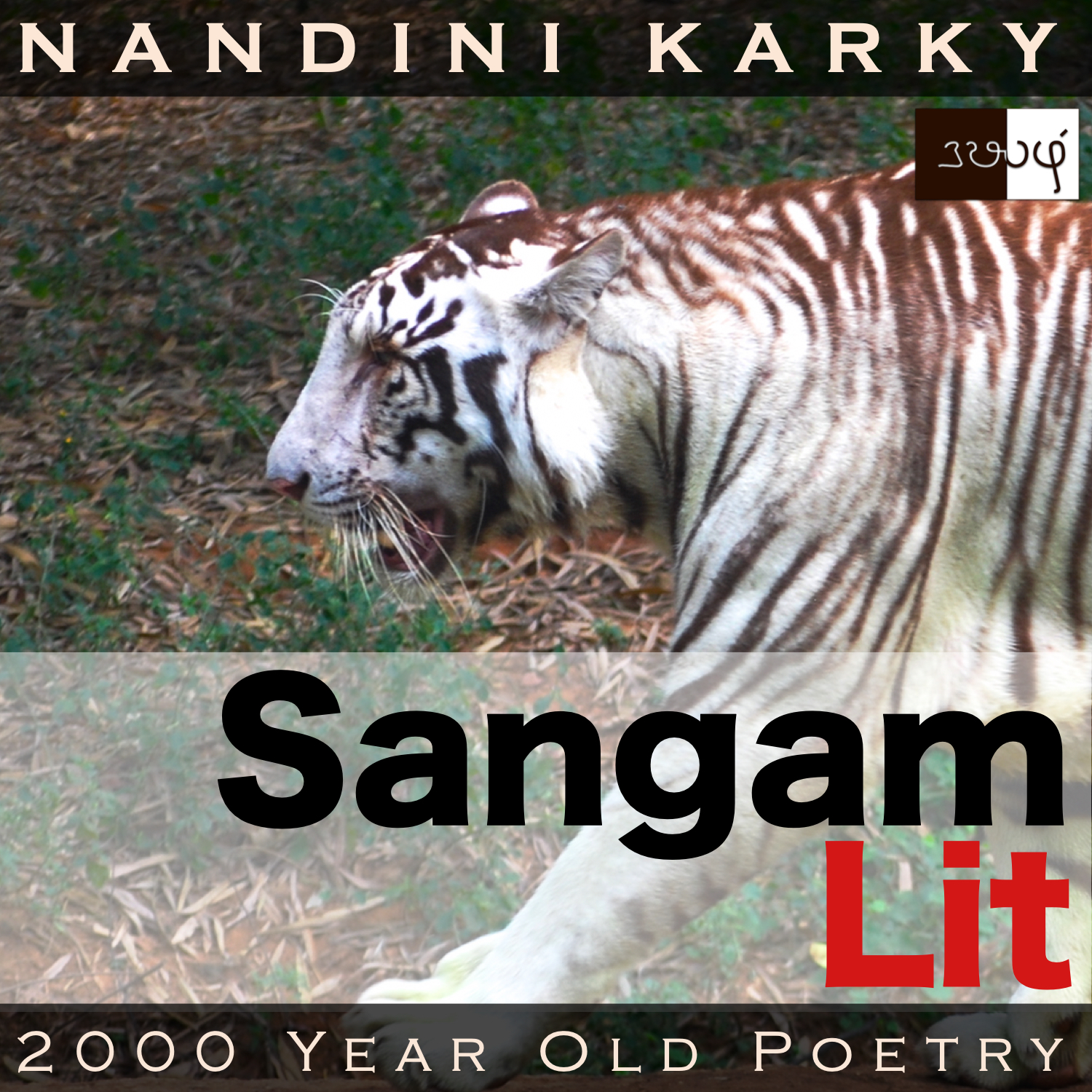Podcast: Play in new window | Download
Subscribe: Apple Podcasts | Spotify | Amazon Music | Android | iHeartRadio | TuneIn | RSS | More

In this episode, we appreciate the inner life depicted in Sangam literary work Natrinai 29, written by Poothanaar. This is the only recovered poem penned by this poet in all of Sangam literature. The landscape is ‘Paalai’ or the drylands, and the poem is expressed in the words of the lady’s mother, hearing news of her daughter’s elopement.
நின்ற வேனில் உலந்த காந்தள்
அழல் அவிர் நீள் இடை, நிழலிடம் பெறாஅது,
ஈன்று கான் மடிந்த பிணவுப் பசி கூர்ந்தென,
மான்ற மாலை, வழங்குநர்ச் செகீஇய,
புலி பார்த்து உறையும் புல் அதர்ச் சிறு நெறி
யாங்கு வல்லுநள்கொல்தானே-யான், ”தன்
வனைந்து ஏந்து இள முலை நோவகொல்!” என
நினைந்து, கைந்நெகிழ்ந்த அனைத்தற்குத் தான் தன்
பேர் அமர் மழைக் கண் ஈரிய கலுழ,
வெய்ய உயிர்க்கும் சாயல்,
மை ஈர் ஓதி, பெரு மடத்தகையே?
The air around sizzled with heat and dryness when reading the poem. ‘நின்ற வேனில்’ meaning ‘long summer’, ‘உலந்த காந்தள்’ meaning ‘dried-up lillies’, ‘அழல்’ meaning ‘heat’ and ‘நிழலிடம் பெறாஅது’ meaning ‘a shadeless spot’ paints images of a parched land, where there’s brown all around and a blazing sun above. To add danger to the dryness, there’s the image of a ‘புலி’ or a tiger, waiting to pounce. In contrast to all this, there’s the reference to a young maiden with tear-filled, cool, moist eyes as echoed by ‘மழைக் கண் ஈரிய கலுழ’. The poem seemed to hold a promise for a study in contrasts.
Turning our attention to the meaning and context of the verse, we meet for the first time, a poem in the words of the ‘நற்றாய்’ or the lady’s birth mother. I say ‘birth mother’ because there were two mothers for a lady in the Sangam era. The one who gives birth to her and the other, the ‘செவிலித்தாய்’ or the foster mother, who raises the child from young. On hearing the news that her daughter has eloped with a man and was seen heading towards the dryland paths, the mother says, “In an unending summer, with the scorching sun above all day, on a long path filled with dried-up flame-lilies, not finding a spot of shade, the female tiger that has just given birth awaits in hunger, guarding her cubs. Feeling the pangs of her hunger, the male tiger stalks prey that walk in the grassy paths as dusk descends. It is on such paths that my girl now walks. How can she bear to walk here? Once, thinking that her painted bosoms might hurt, I relaxed the grip of my embrace and even so, her large, cool, moist eyes filled with tears. She’s such a delicate girl with dark, oiled tresses, filled with much tenderness. How will she handle the harshness in her path?”
A mother’s concern echoes through this poem. The image of the female tiger that has given birth, waiting in guard over her cubs, under that scorching sun, highlights the pain of a mother in the animal world. It’s a different pain, indeed. But a mother’s pain, nevertheless. The lady’s mother paints the portrait of her girl with an anecdote. Once, thinking that her tight embrace would hurt her daughter, she loosened her grip and the girl could not bear even that, as her eyes filled with tears. We sense that she’s someone so tender who cannot even withstand the tightness of a mother’s hug and like the mother, we wonder aghast, how she can face all the terror that lies in wait for her, on her path. Deviating a little from this danger-filled path, let’s turn our attention to a practice in the Sangam era depicted in this poem. This is the practice of painting lines and intricate patterns on the shoulder and chest regions of women with sandalwood called ‘Thoyyil’. Apparently, the tattoo of two thousand years ago! This, we know from the word ‘வனைந்து’ meaning ‘drawn or written’. Amazing isn’t it how a single word can convey the culture of an entire era?
Coming back to the mother and her fear, she is stunned that her daughter, so delicate and tender, unable to even bear the tightness of an embrace, would dare to face such a cruel path. What changed in her girl? Is she unaware of the dangers in her path or does she proceed knowing fully well what lies ahead? I want to turn my attention from the mother’s shock to the daughter’s determination. In complete contrast to her gentle nature, why does she leave for an uncertain future? It reminds me of stories of immense strength in dangerous circumstances such as a mother lifting tons to save her trapped child. The stuff of heroes too! People who stand up to defend, where once they may have been meek and mild souls. Friends of such people would be surprised beyond measure that they ended up doing some such brave thing. How little do we really know of others and even ourselves? Perhaps, we can only hope for ourselves, the extraordinary strength to face any dire circumstance, the kind that we or people dear to us never knew we had, and walk on with determination like that gentle lady facing her path of danger!




Just started to listen to your podcast, during my walk/stroll routine. I enjoy it immensely. I know I have a long way to go to catch up. Like most Tamils, I am unable to comprehend reading directly from the original(மூலம்). I need some hand holding. The format you provide is excellent. It could be even better, if the original poem is recited again at the end, after your interpretative commentary, before closing. The original poem could register better that way, in the listener’s mind. I understand you will have to balance multiple considerations. I was just thinking aloud as a way of feedback.
This is a great effort. Thank You.
anbudan,
kumAr kumarappan